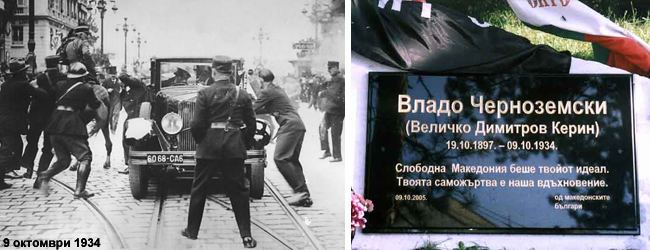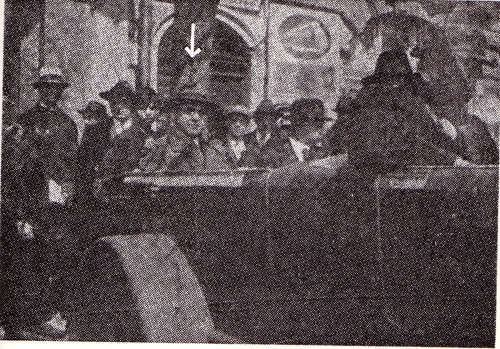Years active 1922–1934 | Name Vlado Chernozemski | |
 | ||
Occupation Assassin, revolutionary Known for Assassination of:Alexander of Yugoslavia (1934)Naum Tomalevski (1930)Dimo Hadzhidimov (1924) Similar People Alexander I of Yugoslavia, Dimo Hadzhidimov, Maria of Yugoslavia, Peter II of Yugoslavia, Peter I of Serbia | ||
Koi beshe vlado chernozemski
Vlado Chernozemski (Bulgarian: Владо Черноземски) (19 October 1897 – 9 October 1934), born Velichko Dimitrov Kerin (Bulgarian: Величко Димитров Керин), was a Bulgarian revolutionary. Also known as "Vlado the Chauffeur", Chernozemski is considered a hero in Bulgaria today, and in his time, in Croatian circles and in the Macedonian Bulgarian diaspora. His contribution to the independence of Macedonia has also won him a similar status in some ethnic Macedonian circles today.
Contents
- Koi beshe vlado chernozemski
- Assassination of Serbian king Aleksandar by Vlado Cernozemski
- Life
- IMRO
- Assassin of the IMRO
- Killing of King Alexander
- References

Chernozemski began his revolutionary activities in 1922, when he joined the Internal Macedonian Revolutionary Organization (IMRO). Soon after, he became an assassin for the IMRO. He killed two notable Bulgarian politicians, communist Dimo Hadzhidimov, and IMRO member Naum Tomalevski. Both times he was sentenced to death, but he escaped from his first imprisonment and was released from the second. After his release in 1932, he became an instructor for the Ustaše. He trained a group of Ustaše to assassinate Alexander of Yugoslavia, but eventually killed Alexander himself on 9 October 1934 in Marseille. He was then beaten by French police and spectators, and died the same day. He also killed French Foreign Minister Louis Barthou in the process.

Assassination of Serbian king Aleksandar by Vlado Cernozemski
Life

Velichko Dimitrov Kerin was born in the village of Kamenitsa, now part of the town Velingrad. His father, Dimitar Kerin, and his mother, Risa Baltadzieva, were both from Kamenitsa. As a youngster, he was prone to drinking alcohol, but later he reformed and became a vegetarian. He joined the military in Plovdiv. During World War I, Chernozemski served in the engineer troops. He married in 1919. After the war he worked as a driver and watchmaker. In 1923, his daughter Latinka was born. In 1925, he divorced and remarried. He lived in Sofia until 1932. There are no records of him beyond that year, but he was re-identified in 1934, after his death.
IMRO

A legend describing Chernozemski as Vlado the Driver (Bulgarian: Владо Шофьора) appeared in Macedonia, since he worked for a company in Dupnitsa as a driver for a short time. In the early 1920s, he moved to Bansko, when the Internal Macedonian Revolutionary Organization (IMRO) was founded by Todor Alexandrov. Chernozemski joined the IMRO in 1922 in the unit Voivode Ivan Barlyo. From 1923 to 1924, he was a member of Trayan Lakavishki's cheta. Chernozemski also entered the region of Vardar Macedonia with IMRO bands and participated in more than 15 skirmishes with Yugoslav police. He soon became one of the best marksmen in the organization, known for his courage, sangfroid and discipline.
Assassin of the IMRO
In 1925 Ivan Mihailov became the new leader of the IMRO. In this period the organization took actions against the former left-wing activists, assassinating several of them. Mihailov assigned Chernozemski to assassinate MP Dimo Hadzhidimov, a member of the Communist Party of Bulgaria and former IMRO member. Chernozemski was arrested and sentenced to death by hanging for Hadzhidimov's assassination, but his execution was never carried out. In 1925, Chernozemski escaped from a police escort.
In 1927, Chernozemski proposed to the IMRO Central Committee to enter the main conference building of the League of Nations in Paris and detonate grenades attached to his person, in order to attract the attention of the world and generate publicity over the question of the Bulgarians in Macedonia, but his proposal was rejected. In 1929, the leadership of the IMRO called on Ante Pavelić and the Ustaše for cooperation.
In 1930, Chernozemski, following an order by Mihailov, assassinated another member of the IMRO, Naum Tomalevski, and his bodyguard. Tomalevski had been a prominent member of the IMRO. For the second time, Chernozemski was sentenced to death, but he was pardoned in 1932.
Killing of King Alexander
After his release from the prison, Chernozemski disappeared. He moved to Italy, where he became an instructor for the Ustaše in a camp in Borgotaro.
He was then transferred to the Ustaše camp in Janka Puszta, near Nagykanizsa in Hungary. The main purpose of this camp was planning for the assassination of King Alexander I. Chernozemski was the instructor of the group that was preparing to assassinate the king. On 9 October 1934, he completed the task, because concluding that members of the group were unprepared psychologically, he decided to carry out the assassination himself. As King Alexander's motorcade drove at a few miles per hour down a Marseilles street for an adoring crowd to view, Chernozemski was able to emerge from the crowd, approach the king's car and leap onto its running board while concealing his Mauser C96 automatic pistol in a bouquet of flowers and chanting "Vive le roi" ("long live the king"). He shot Alexander repeatedly, hitting him twice, once in the abdomen and the other in the heart; King Alexander died within minutes. The chauffeur—who tried to push Chernozemski off the car—and Alexander's companion in the car, French Foreign Minister Louis Barthou, were also shot, the latter apparently unintentionally. The chauffeur died almost immediately, with his foot pressed on the brake of the car, providing the opportunity for a photographer outside the car to photograph most of the grisly affair. Barthou might have survived, but did not, apparently because of inadequate medical attention.
After shooting a policeman who tried to seize him and inadvertently killing two bystanders, Chernozemski then futilely attempted to flee the scene but was struck by a slash from an escorting cavalryman's sabre, stunning him. He then received a non-mortal bullet wound in the head from a rogue police officer, and was savagely beaten by the enraged crowd while the police stood back and watched. Chernozemski was then brought in for interrogation. Since the assassin was in critical condition, he was unable to say anything and succumbed to his injuries later that evening, just 10 days before his 37th birthday. The French police were unable to identify him; they could only register his tattoo, a skull with crossbones and a sign reading "V.M.R.O." (Bulgarian initials standing for Internal Macedonian Revolutionary Organization). He was buried in an unmarked grave in the Marseilles cemeteries with only two detectives and the gravediggers present at the funeral.
For murdering King Alexander I, Chernozemski was posthumously declared the most dangerous terrorist in Europe.
